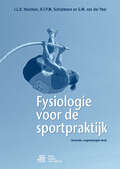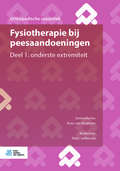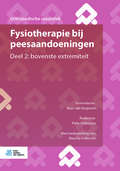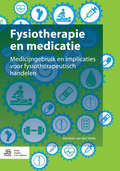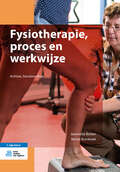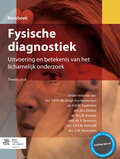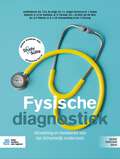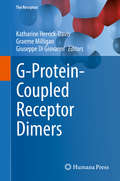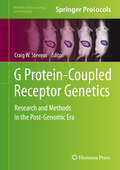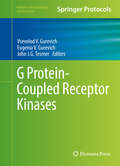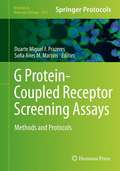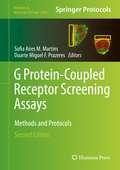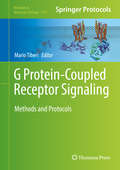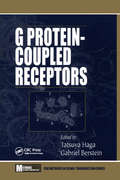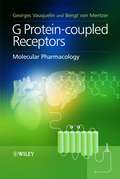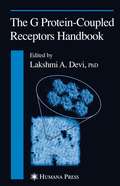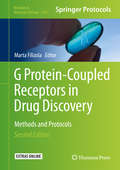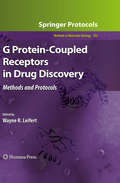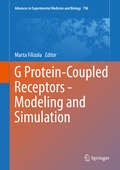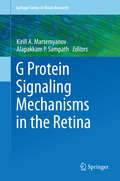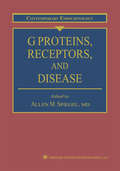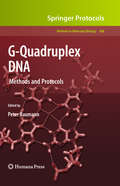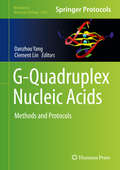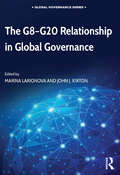- Table View
- List View
Fysiologie voor de sportpraktijk
by I.L.D. Houtman H.F.P.M. Schlatmann G.M. van der PoelEen goede fysiologische kennis helpt bij het beantwoorden van veel vragen die trainers, coaches, verzorgers, sportmasseurs én sporters (zichzelf) stellen. Vaak hebben dat soort vragen namelijk betrekking op de effecten van o.a. inspanning, training, (sport)voeding, hormoonpreparaten, doping, en (hoogte)training. Met dit boek krijgt u de inzichten om de fysiologie van de mens toe te passen in de sportpraktijk. Bij deze zesde druk is o.a. het hoofdstuk over energievoorziening grotendeels herschreven. De belangrijkste aanpassing ten opzichte van de vorige druk is de toevoeging van een volledig nieuw hoofdstuk over training. Fysiologie in de sportpraktijk is zodanig van opbouw dat het uitnodigt tot zelfstudie. Door de overzichtelijke lay out ontdekt u meteen de hoofd- en bijzaken. De bijzaken zijn als een intermezzo weergegeven en zijn bedoeld als illustratie. Aan het eind van ieder hoofdstuk kunt u door middel van vragen uw kennis testen. Aan het slot krijgt u uiteenlopende praktijkopdrachten over een bepaald thema. Zo toetst u automatisch uw opgedane kennis en inzichten uit het hele boek.
Fysiotherapie bij peesaandoeningen: Deel 1: onderste extremiteit (Orthopedische casuïstiek)
by Koos Van Nugteren Patty JoldersmaDit boek beschrijf de meest voorkomende peesaandoeningen van de onderste extremiteit. Van iedere aandoening wordt een voorbeeldcasus beschreven met daarbij de symptomen en belangrijkste bevindingen van het functieonderzoek. Zo wordt duidelijk hoe de aandoening is te herkennen. Als de beschreven aandoening kan worden behandeld met een oefenprogramma dan wordt deze in een apart hoofdstuk beschreven en geïllustreerd. (Sport)fysiotherapeuten, kinesitherapeuten, oefentherapeuten en (sport)artsen kunnen het boek ‘Peesaandoeningen’ gebruiken om hun kennis op te frissen. Door de overzichtelijke opbouw is het boek bovendien geschikt als leerboek voor opleidingsdoeleinden. Dit is uitgave 30 van de serie ‘Orthopedische Casuïstiek’. Tweemaal per jaar verschijnt er een nieuw deel in deze serie. De serie is ook online beschikbaar op abonnementsbasis. Deze uitgave in de serie ‘Orthopedische Casuïstiek’ is geschreven onder redactie van Koos van Nugteren (fysiotherapeut) en Patty Joldersma (sportfysiotherapeut en fitnesstrainer).
Fysiotherapie bij peesaandoeningen: Deel 2: bovenste extremiteit (Orthopedische casuïstiek)
by Koos Van Nugteren Patty JoldersmaDit boek beschrijft de meest voorkomende peesaandoeningen van de bovenste extremiteit. Van iedere aandoening wordt een voorbeeldcasus beschreven met daarbij de symptomen en belangrijkste bevindingen van het functieonderzoek. Zo wordt duidelijk hoe de aandoening is te herkennen. Als de beschreven aandoening kan worden behandeld met een oefenprogramma dan wordt deze in een apart hoofdstuk beschreven en geïllustreerd. (Sport)fysiotherapeuten, kinesitherapeuten, oefentherapeuten en (sport)artsen kunnen het boek 'Peesaandoeningen' gebruiken om hun kennis op te frissen. Door de overzichtelijke opbouw is het boen bovendien geschikt voor opleidingsdoeleinden.Dit is uitgave 31 van de serie 'Orthopedische Casuïstiek'. Twee maal per jaar verschijn er een nieuw deel in deze serie. De serie is ook online beschikbaar op abonnementsbasis.Deze uitgave in de serie 'Orthopedische Casuïstiek' is geschreven onder redactie van Koos van Nugteren (fysiotherapeut) en Patty Joldersma (sportfysiotherapeut en fitnesstrainer).
Fysiotherapie en medicatie: Medicijngebruik en implicaties voor fysiotherapeutisch handelen
by H. van der VeldeFysiotherapeuten zijn verplicht om tijdens de anamnese naar medicijngebruik te vragen. Maar hebben nauwelijks informatie over de gevolgen van medicijngebruik voor de behandeling. Kennis van farmacologie is essentieel bij het signaleren van behandelrisico’s, relatieve contra-indicaties en rode vlaggen. In dit boek wordt nagegaan welke symptomen veroorzaakt worden door medicijnen, hoe de fysiotherapeut dit uit kan vragen tijdens de anamnese en welke gevolgen dit heeft voor de behandeling. Ook de alternatieve en/of OTC geneesmiddelen en hun effecten komen daarbij aan bod,evenals de effecten van voedingssupplementen.
Fysiotherapie, proces en werkwijze
by Jeannette Boiten Marije BunskoekDit boek biedt het kader voor de ontwikkeling van het fysiotherapeutisch onderzoeken en behandelen. Centraal staat het bewust en ethisch verantwoord handelen, eerst denken, dan doen en zorgen voor evidence-based practice. Deze 8e druk van Diagnostiek in de fysiotherapie, proces en werkwijze is aangepast. De inleiding is nu onderdeel van het hoofdstuk Fysiotherapie in de Nederlandse gezondheidszorg. De hoofdstukken Zorgverlening en Probleemoplossing uit de eerdere drukken, zijn gesplitst in vier kleinere hoofdstukken: Gezondheid en ziekte, Zorgverlening, Probleemoplossing en Fysiotherapeutisch methodisch handelen. Daarna volgt, conform eerdere versies, de verheldering van aanmelding met verwijzing of screening, anamnese, onderzoek, diagnose en indicatiestelling, behandelplan, evaluatie, verslaglegging en kwaliteitszorg. Na de eerste druk van dit boek zijn vele KNGF-richtlijnen verschenen. Wanneer richtlijnen (nog) niet aanwezig zijn en wanneer afgeweken moet worden van richtlijnen dan geeft deze 8e druk basisuitgangspunten voor het denkproces van de fysiotherapeut. De inhoud van het boek is geactualiseerd, de essentie is identiek. Het boek ondersteunt en stimuleert het kritisch reflecteren op de eigen werkwijze als professional. De nadruk ligt op logisch redeneren en het onderbouwen van keuzes. Daarbij wordt de relatie tussen cliënt en fysiotherapeut opgevat als een functionele samenwerkingsrelatie, met aandacht voor positieve gezondheid, klinisch redeneren en het gebruik van meetinstrumenten. Het volledige boek is ook digitaal beschikbaar met samenvattingen en toetsvragen per hoofdstuk en interessante en verdiepende links.
Fysische diagnostiek: Uitvoering en betekenis van het lichamelijk onderzoek
by T. O. H. Jongh, H. E. M. Daelmans, M. J. Dekker, W. L. M. Kramer, R. Remmen, Ch. P. M. Verhoeff and G. M. VerwijnenLichamelijk onderzoek vormt nog steeds, samen met de anamnese, de basis van de diagnostiek. De interpretatie van de verkregen gegevens bepaalt of en welk aanvullend onderzoek zinvol is. Dit boek biedt studenten, docenten en praktiserend artsen een langverwachte standaard voor het lichamelijk onderzoek.Fysische diagnostiek is waar mogelijk gebaseerd op wetenschappelijke onderbouwing en daarnaast op een consensus onder vertegenwoordigers van het vaardigheidsonderwijs in Nederland en België. Het geeft het lichamelijk onderzoek op systematische wijze weer. Daarnaast biedt het de lezer inzicht welke bevindingen afwijkend zijn en wat de klinische betekenis daarvan is.De inhoud omvat behalve de systematische beschrijving van het onderzoek bij volwassenen ook hoofdstukken over het lichamelijk onderzoek bij specifieke groepen zoals zwangere vrouwen, pasgeborenen, opgroeiende kinderen en oude mensen.Het boek bevat een groot aantal illustraties van de gebruikte technieken. Daarnaast zijn van alle handelingen filmopnamen gemaakt. Dit materiaal is opgedeeld in circa 140 fragmenten die snel en gemakkelijk op de website bij het boek zijn terug te vinden. De lezer van dit boek heeft kosteloos toegang tot deze website, waar in totaal zo'n zes uur filmmateriaal beschikbaar is. Daarnaast zijn op de website audiofragmenten aanwezig, de inhoud van dit boek en checklists van de verrichte onderzoeken. Dat maakt het voor de lezer mogelijk om vanuit de praktijkvideo’s snel terug te schakelen naar het boek om de beschrijving te lezen van de uitvoering van het lichamelijk onderzoek en de klinische betekenis van de bevindingen.In deze nieuwe druk is een hoofdstuk over het opgroeiende kind toegevoegd en zijn de teksten geactualiseerd en aangevuld. De website is uitgebreid met een aantal nieuwe filmfragmenten en met checklists waarin de inhoud van het lichamelijk onderzoek schematisch wordt weergegeven.Fysische diagnostiek is primair bedoeld om aan studenten geneeskunde en paramedische beroepen op systematische, gestandaardiseerde manier het lichamelijk onderzoek aan te leren. Daarnaast is Fysische diagnostiek van groot belang voor alle artsen en medewerkers in paramedische beroepen die meer willen weten over de juiste uitvoering van het lichamelijk onderzoek en de klinische betekenis van de gevonden afwijkingen. Dit inzicht kan hen ondersteunen in de besluitvorming bij mogelijk afwijkende bevindingen.
Fysische diagnostiek: Uitvoering en betekenis van het lichamelijk onderzoek
by T.O.H. de Jongh F.J. Jongen-Hermus J. Damen H.E.M. Daelmans R. Franssen I. de Klerk-van der Wiel A. D. Pieterse B.J.J.W. Schouwenberg F. SchuringLichamelijk onderzoek vormt, samen met de anamnese, de basis van de diagnostiek. De interpretatie van de verkregen gegevens bepaalt of en welk aanvullend onderzoek zinvol is. Dit boek biedt studenten, docenten en praktiserend artsen een standaard voor het lichamelijk onderzoek. Fysische diagnostiek geeft het lichamelijk onderzoek op systematische wijze weer. De relevante anatomie en fysiologie wordt beschreven als basis voor het goed kunnen verrichten van het lichamelijk onderzoek. Daarnaast biedt het boek inzicht in normale en afwijkende bevindingen en wat de klinische betekenis daarvan is. Behalve de systematische beschrijving van het onderzoek bij volwassenen zijn er ook hoofdstukken over het lichamelijk onderzoek bij specifieke groepen zoals zwangere vrouwen, pasgeborenen, kinderen en geriatrische patiënten. Van alle beschreven handelingen zijn video-opnamen gemaakt. In totaal gaat het om meer dan 150 fragmenten. Deze zijn te raadplegen in de online leeromgeving StudySuite, waar ook audiofragmenten en de inhoud van dit boek te vinden zijn. Op StudySuite kan de lezer gemakkelijk schakelen tussen de video’s en de inhoud. In deze nieuwe druk is een andere indeling gemaakt met een duidelijk onderscheid tussen het algemene onderzoek en het onderzoek op indicatie. Ook zijn er hoofdstukken over het mentale status onderzoek, het algemeen internistisch onderzoek bij volwassenen en hoofdstukken met achtergrondinformatie over de communicatie en hygiëne tijdens het lichamelijk onderzoek toegevoegd. De teksten zijn waar nodig geactualiseerd en aangevuld, o.a. met veel nieuwe afbeeldingen. Elk hoofdstuk is voorzien van een checklist waarin de inhoud van het lichamelijk onderzoek schematisch wordt weergegeven. Fysische diagnostiek is primair bedoeld voor studenten geneeskunde, verpleegkundig specialisten en medisch specialisten in opleiding om op een systematische manier het lichamelijk onderzoek aan te leren. Daarnaast is het boek van belang voor artsen, docenten en medewerkers in paramedische beroepen, die meer willen weten over de juiste uitvoering van lichamelijk onderzoek en de klinische betekenis van gevonden afwijkingen. Dit boek is tot stand gekomen door samenwerking vanuit alle acht Nederlandse UMC’s en faculteiten, met input van Belgische collega’s. Er is ook een Engelse vertaling van dit boek inclusief de video’s beschikbaar.
G-Protein-Coupled Receptor Dimers (The Receptors #33)
by Katharine Herrick-Davis Graeme Milligan Giuseppe Di GiovanniG-protein-coupled receptors (GPCRs) are believed to be the largest family of membrane proteins involved in signal transduction and cellular responses. They dimerize (form a pair of macromolecules) with a wide variety of other receptors. The proposed book will provide a comprehensive overview of GPCR dimers, starting with a historical perspective and including, basic information about the different dimers, how they synthesize, their signaling properties, and the many diverse physiological processes in which they are involved. In addition to presenting information about healthy GPCR dimer activity, the book will also include a section on their pathology and therapeutic potentials.
G Protein-Coupled Receptor Genetics: Research and Methods in the Post-Genomic Era (Methods in Pharmacology and Toxicology)
by Craig W. StevensG Protein‐Coupled Receptor Genetics: Research and Methods in the Post‐Genomic Era features practical techniques inspired by the fast moving GPCR field. From powerful bioinformatic tools tracing the evolution of GPCRs, to methods for the cellular transfection of engineered viruses containing GPCRs, to optogenetic techniques that produce light-activated GPCRs in live mice, what was once science fiction is now science fact. This detailed volume includes sections covering genetic mechanisms, a genetic toolbox for GPCR discovery, as well as genetic aspects of G protein-coupled receptors in health and medicine. Written for the Methods in Pharmacology and Toxicology series, this book contains the kind of key implementation advice that encourages successful results in the lab.Authoritative and easy to use, G Protein‐Coupled Receptor Genetics: Research and Methods in the Post‐Genomic Era serves as an ideal guide for researchers aiming to continue our progress in this dynamic and exciting area of study.
G Protein-Coupled Receptor Kinases (Methods in Pharmacology and Toxicology)
by Vsevolod V. Gurevich, Eugenia V. Gurevich and John J.G. TesmerThis collection explores up-to-date descriptions of known G protein-coupled receptor kinase (GRK)-dependent mechanisms, both associated with G protein-coupled receptor (GPCR) functions and the receptor-independent. The chapters cover a wide range of studies from invertebrates to humans, with sections of the volume covering GRK structure, mechanisms of activation, and interaction with GPCRs, GRKs in cell signaling, as well as physiological and pathophysiological mechanisms regulated by GRKs. Written for the Methods in Pharmacology and Toxicology series, this book features the kind of practical detail necessary for success in the laboratory. Authoritative and timely, G Protein-Coupled Receptor Kinases features the kind of comprehensive mechanistic elucidation of GRK functions and their regulation in cells necessary for a better understanding of cell biology as well as for devising novel research approaches and therapeutic strategies.
G Protein-Coupled Receptor Screening Assays: Methods and Protocols (Methods in Molecular Biology #1272)
by Duarte Miguel F. Prazeres Sofia Aires M. MartinsThis volume explores the considerable efforts that have been directed towards the development of G Protein-Coupled Receptors (GPCR) screening assays in order to disclose GPCR acting compounds, elucidate signaling mechanisms or evaluate compound’s efficacy. New discoveries in the field, along with the widely recognized need for better and safer pharmaceutical drugs constitute the main motivation for this book. Readers, both beginners and experienced researchers, will receive an updated overview of not only the established, but also the innovative technologies that promise to advance GPCR drug research. This book is organized into two major parts: the introductory part discusses the necessary foundations for the understanding of GPCR action and the rationale behind the design of the available screening assays; and part two provides detailed protocols for different screening approaches. Written in the highly successful Methods in Molecular Biology series format, the chapters include the kind of detailed description and implementation advice that is crucial for getting optimal results in the laboratory.Practical and innovative, G Protein-Coupled Receptor Screening Assays: Methods and Protocols reaches out to everyone involved in the discovery of GPCR-active drugs, and provides a transversal overview of the different levels of GPCR signaling addressable in the different screening strategies and presents practical examples of how current assay technologies are contributing to new paradigms in GPCR drug research.
G Protein-Coupled Receptor Screening Assays: Methods and Protocols (Methods in Molecular Biology #2268)
by Duarte Miguel F. Prazeres Sofia Aires M. MartinsThis fully updated edition targets not only those assays directly involved in the discovery of GPCR-active compounds but also those involved in cell-based experiments designed to study physiological responses. Whether coming from academia or industry, or being an experienced researcher or a newcomer to the field, the reader will find accessible methods and protocols that cover the latest developments on receptor purification, molecular biology, recombinant engineering, and analytical techniques that enable the real time monitoring of the complex GPCR signaling cascade and identification of potential drug targets. Written for the highly successful Methods in Molecular Biology series, chapters include introductions to their respective topics, lists of the necessary materials and reagents, step-by-step, readily reproducible laboratory protocols, and tips on troubleshooting and avoiding known pitfalls. Authoritative and up-to-date, G Protein-Coupled Receptor Screening Assays: Methods and Protocols, Second Edition aims to provide the tools necessary to contribute to the advancement of GPCR research and discovery and ultimately lead to the availability of innovative and more efficient drugs.
G Protein-Coupled Receptor Signaling: Methods and Protocols (Methods in Molecular Biology #1947)
by Mario TiberiThis detailed volume assembles comprehensive protocols to assist with the study of structural, molecular, cell biological, and in vivo facets of GPCRs, and to enable the development of experimental tools for screening novel GPCR drugs. Sections explore the tweaking of ligands, bioluminescence and FRET approaches, specific GPCR signaling properties, as well as visualization of subcellular compartmentalization. Written for the highly successful Methods in Molecular Biology series, chapters include introductions to their respective topics, lists of the necessary materials and reagents, step-by-step, readily reproducible laboratory protocols, and tips on troubleshooting and avoiding known pitfalls. Authoritative and practical, G Protein-Coupled Receptor Signaling: Methods and Protocols serves as an ideal reference for life scientists working in a variety of research fields including molecular pharmacology, cell and developmental biology, brain behavior and physiology, drug development and screening.Chapter 4 is available open access under a CC BY 4.0 license via link.springer.com.
G Protein-Coupled Receptors
by Gabriel BersteinCovering recently developed methods in membrane-bound receptors, this book emphasizes receptor structure and function, knowledge of which is essential to the study of signal transduction.G Protein-Coupled Receptors has culled contributors from domestic and international sources, providing a broad base of knowledge. Some topics covered are the r
G Protein-Coupled Receptors
by Tatsuya Haga and Gabriel BersteinCovering recently developed methods in membrane-bound receptors, this book emphasizes receptor structure and function, knowledge of which is essential to the study of signal transduction.G Protein-Coupled Receptors has culled contributors from domestic and international sources, providing a broad base of knowledge. Some topics covered are the r
G Protein-coupled Receptors: Molecular Pharmacology
by Georges Vauquelin Bengt von MentzerG protein-coupled receptors (GPCRs) are membrane proteins that transduce a vast array of extracellular signals into intracellular reactions ranging from cell-cell communication processes to physiological responses. They play an important role in a variety of diseases from cancer and diabetes, to neurodegenerative, inflammatory and respiratory disorders. GPCRs are therefore of utmost interest in drug development: over half of all prescription drugs currently on the market act by targeting these receptors directly or indirectly. G Protein-coupled Receptors: Molecular Pharmacology provides a clear summary of the current knowledge in this fast-evolving field. The book sets out with an introduction to signalling molecules and their receptors, and an overview of the technical approaches used to investigate these interactions. Structural, functional and especially pharmacological aspects of GPCRs are then discussed in more detail and much attention is devoted to the analysis and interpretation of experimental data. The now widespread use of recombinant cell lies, receptor mutants and related artifices in drug research is critically evaluated. Special attention is also devoted to topical but often poorly understood concepts, such as insurmountable antagonism, inverse agonism and allosteric interactions. By combining general information with the major state-of-the-art concepts in GPCR-research, this outstanding book equips the reader with the necessary background for understanding and critically evaluating the current literature. Written by two experts from academia and industry, G Protein-coupled Receptors: Molecular Pharmacology offers a unique view of academic and applied approaches aiming to reveal new ideas in pharmaceutical research. The book is of interest to anyone involved in drug development and preclinical research and those who need to function within multi-disciplinary teams in the pharmaceutical industry: from investigators to product managers or clinicians who seek to have a broad mechanistic understanding of drug-receptor interactions. It is also an invaluable resource for final year undergraduate and postgraduate students in pharmacology and cell and molecular biology.
The G Protein-Coupled Receptors Handbook (Contemporary Clinical Neuroscience)
by Lakshmi A. DeviA comprehensive survey of the many recent advances in the field of G protein-coupled receptors (GPCR). The authors describe the current knowledge of GPCR receptor structure and function, the different mechanisms involved in the regulation of GPCR function, and the role of pharmacological chaperones in GPCR folding and maturation. They also present new findings about how GPCR dimerization/oligomerization modifies the properties of individual receptors and show how recent developments are leading to significant advances in drug discovery, such as the detection of ligands for orphan GPCRs. Also discussed are the most recent developments that could lead to new drug discoveries: the role of GPCRs in mediating pain, the development of receptor-type selective drugs based on the structural plasticity of receptor activation, and the identification of natural ligands of orphan GPCRs (deorphanization) as possible drug targets.
G Protein-Coupled Receptors in Drug Discovery: Methods and Protocols (Methods in Molecular Biology #1335)
by Marta FilizolaThis detailed volume provides an overview of recent techniques employed in the field of G protein-coupled receptors (GPCRs) to screen for new drugs and to derive information about their receptor structure, dynamics, and function for the purpose of developing improved therapeutics. Owing to remarkable recent advances in the structural, biophysical and biochemical analyses of these receptors, as well as a growing body of evidence hinting at the possible relevance of allosteric modulators, biased agonists and oligomer-selective ligands as improved therapeutic agents, drug discovery for GPCRs has recently taken a completely new direction. For this book, expert contributors have shared their protocols and views on the impact of these methodologies on modern drug discovery. Written for the highly successful Methods in Molecular Biology series, chapters include introductions to their respective topics, lists of the necessary materials and reagents, step-by-step, readily reproducible laboratory protocols and tips on troubleshooting and avoiding known pitfalls.Practical and fully updated, G Protein-Coupled Receptors in Drug Discovery: Methods and Protocols, Second Edition serves as an ideal guide for a diverse audience from structural and molecular biologists to pharmacologists and drug designers who wish to explore this extensive class of key drug targets.
G Protein-Coupled Receptors in Drug Discovery (Methods in Molecular Biology #552)
by Wayne R. LeifertThe G protein-coupled receptors (GPCRs) and associated peripheral G proteins underpin a multitude of physiological processes. The GPCRs represent one of the largest superfamilies in the human genome and are a significant target for bioactive and drug discovery programs. It is estimated that greater than 50% of all drugs, including those in development, currently target GPCRs. Many of the characterized GPCRs have known ligands; however, approximately 20% of GPCRs are described as orphan GPCRs, apparent GPCRs that share the generic high-level structure charact- istic of GPCRs but whose endogenous ligand is not known. Therefore, it is expected that the field of GPCR drug discovery and development will greatly expand in the coming years with emphasis on new generations of drugs against GPCRs with unique therapeuticuseswhichmayincludedrugssuchasallostericregulators,inverseagonists, and identification of orphan GPCR ligands. AswelearnmoreaboutthemolecularsignalingcascadesfollowingGPCRactivation, we acquire a better appreciation of the complexity of cell signaling and as a result, also acquire a vast array ofnew molecularmethods toinvestigate these andother processes. Thegeneralaimofthisbookistoprovideresearcherswitharangeofprotocolsthatmay be useful in their GPCR drug discovery programs. It is also the basis for the devel- ment of future assays in this field. Therefore, the range of topics covered and the appropriate methodological approaches in GPCR drug discovery are reflected in this book. Itisinterestingtonotethatfuturedirectionsindrugdiscoverywillrequireinput and collaboration from a plethora of fields of research. As such, this book will likely be of interest to scientists involved in such fields as molecular biology, pharmacology, biochemistry, cellular signaling, and bio-nanotechnology.
G Protein-Coupled Receptors - Modeling and Simulation (Advances in Experimental Medicine and Biology #796)
by Marta FilizolaG protein-coupled receptors (GPCRs) are heptahelical transmembrane receptors that convert extra-cellular stimuli into intra-cellular signaling, and ultimately into biological responses. Since GPCRs are natural targets for approximately 40% of all modern medicines, it is not surprising that they have been the subject of intense research. Notwithstanding the amount of data generated over the years, discovering ligands of these receptors with optimal therapeutic properties is not straightforward and has certainly been hampered for years by the lack of high-resolution structural information about these receptors. Luckily, there has been a steady increase of high-resolution crystal structures of these receptors since 2007, and this information, integrated with dynamic inferences from computational and experimental methods, holds great potential for the discovery of new, improved drugs. This book, which provides, for the first time, state-of-the-art views on modeling and simulation of GPCRs, is divided into 4 parts. In the first part, the impact of currently available GPCR crystal structures on structural modeling is discussed extensively as are critical insights from simulations in the second part of the book. The third part reports recent progress in rational ligand discovery and mathematical modeling, whereas the fourth part provides an overview of bioinformatics tools and resources that are available for GPCRs.
G Protein Signaling Mechanisms in the Retina (Springer Series in Vision Research #3)
by Kirill A. Martemyanov Alapakkam P. SampathThe main purpose of this volume is to provide a focused analysis of the function of the G protein-coupled signaling pathways that operate in the interconnected network of retinal neurons as they detect and encode the information carried by light. The organization of this volume will generally follow the path of signal flow in the retina. First we will describe recent advances in understanding the phototransduction cascade of rod and cone photoreceptors, which use signaling cascade based on the GPCR rhodopsin to transduce incident light into neural activity. Chapters will be devoted to unique specializations of the two major types of photosensitive cells that comprise the predominant input for our spatial and color vision. Subsequently, the mechanisms of synaptic information encoding by retinal ON bipolar cells will be described, where the GPCR mGluR6 plays a fundamental role. Chapters in this section will examine macromolecular organization of the mGluR6 signaling pathway as well as current understanding of its function. The functional characteristics of this signaling mechanism will be explored in detail. Additionally, this section will cover the role of dopamine receptors in modulating signal transmission between photoreceptors and ON-bipolar cells. Finally, chapters will be focused on the output neurons of the inner retina, ganglion cells, where the components of the emerging GPCR melanopsin cascade in intrinsically photosensitive ganglion cells will be detailed. Collectively these mechanisms allow the retina to represent visual space over a wide range of light intensities.
G-Quadruplex DNA: Methods and Protocols (Methods in Molecular Biology #608)
by Peter BaumannRecent work has revealed that stabilizing G-quadruplexes in telomeric DNA inhibits telomerase activity, providing impetus for the development of G-quartet-interacting drugs, while G-quartet-containing oligonucleotides have been recognized as a potent class of aptamers effective against STAT3 and other transcription factors implicated in oncogenesis, proving these guanine-quartets to be a vital and rich area for future study. In "G-Quadruplex DNA: Methods and Protocols", experts in the field present a collection of detailed techniques for studying G-quartet formation, dynamics, and molecular recognition. Written in the highly successful Methods in Molecular Biology™ series format, chapters include brief introductions to their respective topics, lists of the necessary materials and reagents, step-by-step, readily reproducible laboratory protocols, and notes on troubleshooting and avoiding known pitfalls. Authoritative and cutting-edge, "G-Quadruplex DNA: Methods and Protocols "promises to be a useful resource for those familiar with G-quartets as well as an easy entry point for those researchers from diverse fields who are just developing an interest in the exciting implications of G-quadruplex DNA.
G-Quadruplex Nucleic Acids: Methods and Protocols (Methods in Molecular Biology #2035)
by Danzhou Yang Clement LinThis volume covers the structures, properties, and functions of G-quadruplexes in a wide range of biological disciplines, including therapeutic intervention and biomaterial application. The chapters in this book explore a wide range of vital and new experimental techniques used in the study of G-quadruplexes. Written in the highly successful Methods in Molecular Biology series format, chapters include introductions to their respective topics, lists of the necessary materials and reagents, step-by-step, readily reproducible laboratory protocols, and tips on troubleshooting and avoiding known pitfalls. Practical and cutting-edge, G-Quadruplex DNA: Methods and Protocols is a valuable resource for both novice and experienced researchers who work in biophysics, structural biology, computational biology, biochemistry, and molecular and cell biology, and who want to learn more about the potential roles and effects of G-quadruplex in these fields.
The G8-G20 Relationship in Global Governance (Global Governance)
by John J. Kirton Marina LarionovaIf the growing demand for global governance breathed new life into the established G7/8 and the more recent G20, it raised questions about the evolving and optimal relationship between them. One answer arose from the G20’s third summit, when it proclaimed the G20 would govern global finance and economics, while the old G8 would focus on development and security. Yet this rough division of labour did not address which issues lay within each category and how interconnections would be addressed to create comprehensive, coherent global governance for a complex world. This volume considers these questions. It explores the summits’ performance, the division of labour during their coexistence, their comparative strengths and limitations, and how the future partnership could be improved to benefit the global community. The authors explain the recent evolution and performance of the G8 and G20 summits and their evolving empirical relationship. They consider the G8/G20 relationship with other actors engaged in global governance, notably the major multilateral organizations and civil society. They assess G7/8 and G20 effectiveness and accountability. And they identify, based on this empirical and analytical foundation, how the relationship can be improved for today’s tightly wired world.
